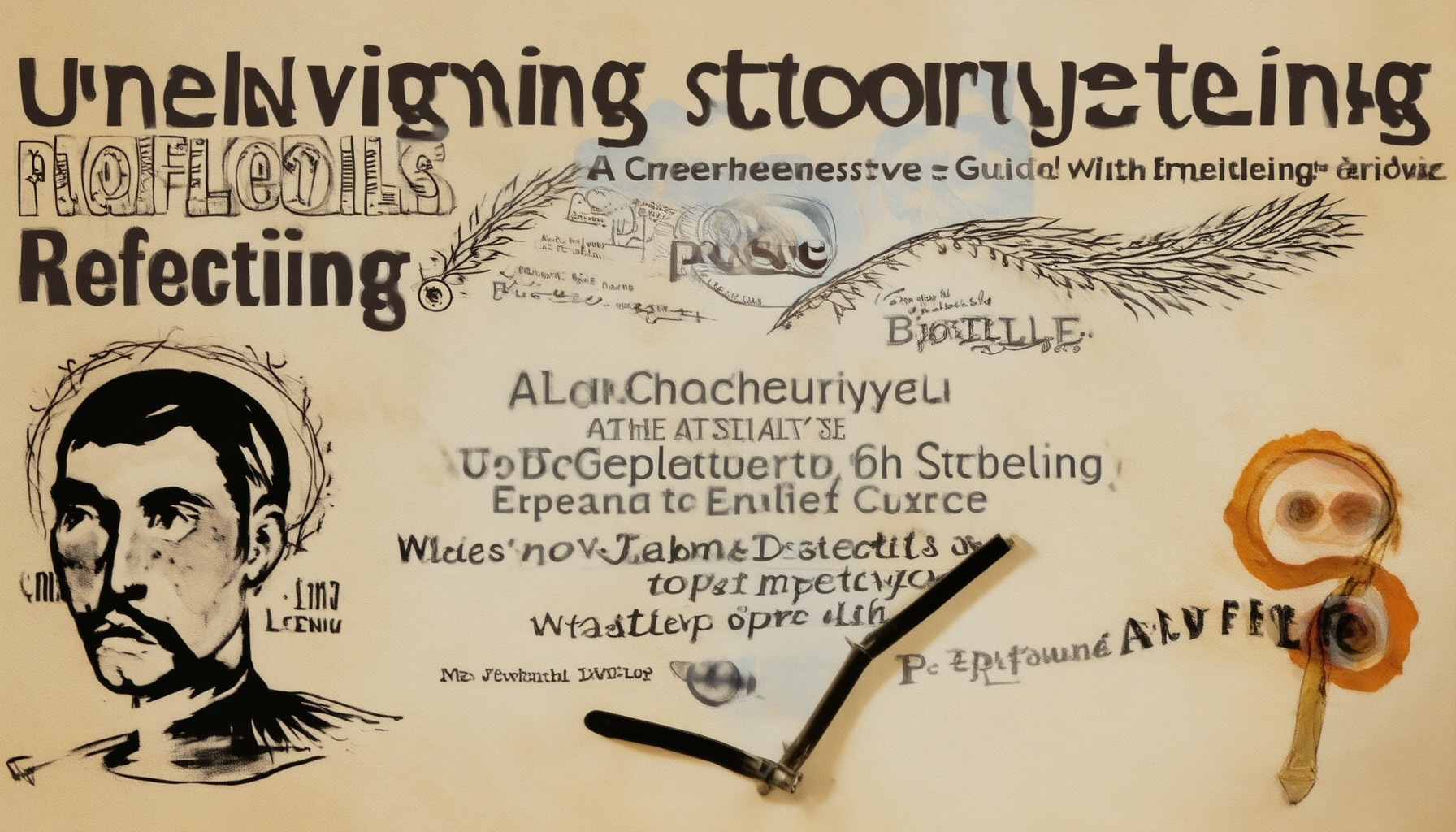In the realm of storytelling, few concepts hold as much power as the ability to reflect and evolve. Creative storytelling reflections offer a unique lens through which narratives can be dissected, reimagined, and transformed, making them invaluable tools for authors, marketers, educators, and anyone seeking to craft compelling messages. Whether you’re crafting a tale that resonates deeply with your audience or refining a business strategy, understanding the intricacies of creative storytelling reflections is essential in today’s fast-paced world.
Key Takeaways
– Craft Compelling Narratives: Master the 7 key components of storytelling—hook, setup, inciting incident, pinch point, resolution, themes, and emotional arc—to create captivating narratives that resonate deeply with audiences.
– Leverage the 3 Cs: Use Context to set the stage, Choice to enhance engagement, and Consequence to drive the plot forward, ensuring every decision impacts the story.
– Uphold the 5 Cs: Develop Character, establish Context, introduce Conflict, build toward a Climax, and deliver a satisfying Closure to craft memorable and impactful stories.
– Focus on Creativity: Infuse originality and innovation into your storytelling to inspire and engage readers, turning ordinary tales into extraordinary experiences.
– Engage Audiences: Capture attention early, maintain interest throughout, and leave a lasting impression with well-crafted plots and relatable characters.
– Elevate Your Craft: Study successful examples and learn from experts like Patrick Mettraux to refine your storytelling skills and create stories that inspire action and reflection.

The Four Pillars of Storytelling
The art of storytelling is built on four essential pillars that work together to create engaging and memorable narratives. Understanding these pillars helps in crafting stories that resonate with audiences effectively.
- People : At the heart of every great story are the characters, or “People.” These can be individuals, groups, or even abstract concepts. The development of these characters drives the plot forward and allows readers to connect emotionally.
- Characters often undergo arcs of transformation, adding depth and relatability to the story.
- Places : The setting or “Place” plays a crucial role in shaping the story’s mood and atmosphere. Whether it’s a bustling city, a serene forest, or a mysterious castle, the environment influences the narrative’s tone and pacing.
- Settings can also symbolize larger themes or challenges the protagonist must face.
- Purposes : Every story has a central goal or “Purpose.” This could be the quest for a holy grail, the search for identity, or the struggle against oppression. The purpose gives the story direction and keeps the audience engaged.
- The purpose often aligns with broader themes, such as self-discovery or redemption.
- Plots : The sequence of events forms the “Plot,” which moves the story forward. A well-structured plot ensures that the story flows logically, with rising action, climax, and resolution.
- A plot can be linear or non-linear, depending on the style of storytelling.
By balancing these four elements, storytellers can craft narratives that captivate audiences and leave a lasting impact.
What is Reflective Storytelling?
Reflective storytelling is a practice where individuals pause to assess, understand, and contextualize their experiences. This approach allows for deeper self-awareness and insight, fostering personal growth and emotional intelligence.
Why is Reflective Storytelling Important?
- Enhances self-awareness and introspection.
- Aids in processing complex emotions and experiences.
- Facilitates better decision-making and problem-solving.
- Encourages empathy and understanding of others’ perspectives.
How Does Reflective Storytelling Work in Daily Life?
Reflective storytelling can be applied to various aspects of life, including:
- Personal journaling or diary entries.
- Discussing events with friends or mentors.
- Analyzing artistic works or creative expressions.
- Evaluating decisions and their outcomes.
The Impact of Reflective Storytelling
When practiced consistently, reflective storytelling can lead to:
- Increased self-confidence and self-esteem.
- Improved relationships and communication skills.
- Greater resilience in facing challenges.
- A more authentic and fulfilling life.
Discover more insights and practical guidance on reflective storytelling by exploring Patrick Mettraux , a platform dedicated to inspire creative expression and personal growth through thoughtful storytelling.

The Five P’s of Storytelling
Storytelling is a powerful tool that can captivate audiences and convey messages effectively. To craft a compelling story, it’s essential to master the five key elements known as the “Five P’s”: People, Place, Pictures, Personal, and Platform.
- People: At the heart of every great story are relatable and multifaceted characters. Develop well-rounded protagonists and antagonists who drive the narrative forward. Make your characters memorable and allow them to grow throughout the story.
- Place: Setting plays a crucial role in shaping the tone and atmosphere of your story. Whether it’s a bustling city, a serene countryside, or a mysterious forest, the environment should reflect the mood and plot developments.
- Pictures: Visual elements, whether through descriptions or imagery, enhance the storytelling experience. Use vivid language to paint scenes in the reader’s mind, helping them visualize the action and emotions being conveyed.
- Personal: Inject your unique perspective and personality into the story. Authenticity resonates with readers, so let your voice shine through the narrative. Share personal reflections or experiences that add depth to your tale.
- Platform: Choose the right medium to share your story. Whether it’s through written words, spoken words, or visual media, ensure your story reaches its intended audience effectively. Consider platforms like blogs, podcasts, or social media to maximize visibility.

What Are the 7 Points of Storytelling?
The art of storytelling is a powerful tool used across various fields, from literature to marketing. To create an engaging and effective narrative, many storytellers follow a structured approach. Below are seven key components of storytelling:
- Hook:** Introduce an intriguing premise or character to capture the audience’s attention early on.
- Setup:** Establish the world, characters, and the central conflict or problem.
- Inciting Incident:** The catalyst that disrupts the status quo, propelling the story forward.
- Pinch Point:** A moment of high tension or revelation that changes the story’s direction.
- Resolution:** Conclude the main plotline, resolving conflicts, and delivering a satisfying ending.
- Themes:** Underlying messages or lessons that give the story depth and meaning.
- Emotional Arc:** The journey of the protagonist’s emotional development throughout the story.
These elements work together to create a cohesive and compelling narrative, ensuring that stories resonate with audiences on multiple levels. By mastering these points, writers can craft tales that are memorable and impactful.
For more insights into storytelling techniques, visit Patrick Mettraux , where you’ll find articles on creativity, inspiration, and storytelling tips.
What Are the 3 C’s of Storytelling?
The 3 C’s of storytelling are essential elements that make any narrative engaging and memorable. These components are:
- Context – Every great story begins with a context that provides the setting, background, and purpose. Context gives the audience a foundation to understand the plot and characters.
- Choice – Providing the audience with meaningful choices enhances engagement. Whether it’s deciding the fate of a character or solving a mystery, giving control to the reader or viewer keeps them invested.
- Consequence – Every choice in a story leads to a consequence. This creates tension and drives the narrative forward, showing the impact of actions taken.
By incorporating these elements effectively, storytellers can craft compelling tales that resonate with audiences. Whether it’s through written words, visual media, or presentations, understanding the 3 C’s ensures your story stands out and captivates attention.

What Are the 5 Cs of Storytelling?
The 5 Cs of storytelling are essential components that help create engaging, memorable, and impactful stories. These elements work together to captivate audiences and convey meaningful messages effectively.
- Character
- Context
- Conflict
- Climax
- Closure
1. Character
A strong character is the heart of any story. Whether it’s a protagonist or an antagonist, the character needs depth to resonate with the audience. For example, in Star Wars: A New Hope , Luke Skywalker’s journey from a farm boy to a hero is relatable and inspiring. His character development drives the narrative forward.
2. Context
Context provides the setting and background information that grounds the story. Without context, the audience struggles to connect with the events. For instance, in the film Joker , Arthur Fleck’s mental state and societal pressures are crucial in understanding his transformation into the Joker.
3. Conflict
Conflict propels the story forward and creates tension. It can be internal or external, but it must challenge the characters in meaningful ways. In Schindler’s List , the conflict between good and evil, hope and despair, keeps viewers engaged until the final moments.
4. Climax
The climax is the peak of the story where the main conflict reaches its resolution. It often leaves a lasting impression. In The Dark Knight , the climax with the Joker’s fate and Batman’s sacrifice is unforgettable.
5. Closure
Effective closure ties up loose ends and leaves the audience satisfied. It doesn’t always mean a happy ending, but it should feel complete. In Forrest Gump , the resolution brings closure to both the character’s journey and the historical events depicted.
Why the 5 Cs Matter
Educating yourself on the 5 Cs of storytelling allows you to analyze and create better narratives. By focusing on these elements, you can craft stories that resonate with your audience and leave a lasting impact. Explore more storytelling tips and insights on Patrick Mettraux .





0 Comments